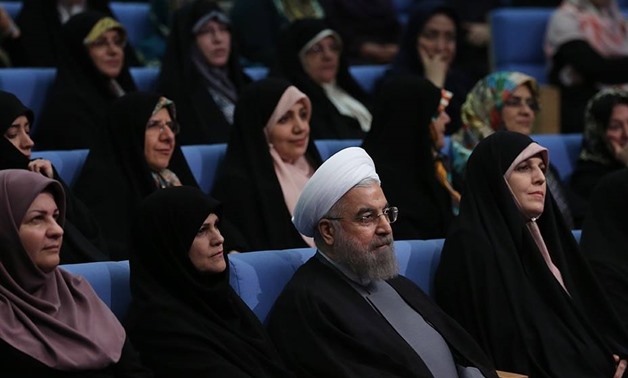
Rouhani surrounded by women official Facebook Page
CAIRO – 19 May 2017: Iranians headed to the polls on Friday to elect a new President and to choose their villages and Cities Councils’ chiefs. The winner in the presidential race will be the 8th president of the Islamic Republic of Iran since the Islamic Revolution in 1979. The Iranians also elect their local Municipal Councils’ chiefs Friday.
A few days ago, two presidential candidates withdrew from the presidential race. Mohammad Bagher Ghalibaf withdrew and endorsed Ebrahim Raisi in a statement on Monday, while Eshaq Jahangiri withdrew in favor of Hassan Rouhani, in a speech in Shiraz on Tuesday. Therefore, the Iranian voters have four candidates to choose from; Mostafa Mir-Salim, Mostafa Hashemitaba, Ebrahim Raisi and Hassan Rouhani.
Observers see the actual presidential race has only two contenders; Raisi and Rouhani. The Iranians have to choose between a conservative (Raisi) and a moderate (to some extent) reformist (Rouhani).
Women political participation
A total of 1,636 men and women signed up to run, an increase of almost 1,000 over the 686 candidates in the 2013 poll. Among them was a record number of 137 women, according to the Iranian Interior Ministry. This year witnesses a 0.9 percent increase in the number of female candidates running for local elections, compared to the 2013 elections.
Sha'la Tabrizi, who has a PhD in Political Science, was the first woman to register for this year's presidential race. "Women constitute 60 percent of Iranian society, so they should strive for one of them to become a powerful president some day," she told local media.
Azam Taleghani was the first woman to register to run for the Iranian presidential election in 1997. She is a politician and journalist, daughter of prominent Islamic Revolution leader Mahmoud Taleghani, born in 1944, head of the Society of Islamic Revolution Women of Iran and editor of Payam Hajar Weekly. She won a seat in the Iranian Parliament (1980-1984). She registered for the presidential elections four times; 1997, 2001, 2009, and 2017.
Does Iranian law permit female presidential candidates?
The Guardian Council of the Constitution is charged with supervising the elections, and approving candidates registered for the presidential, parliamentary and Assembly of Experts elections. The 12-member Guardian Council has never approved a woman for the Presidential race. In the 2009 election, 476 men and women applied to the Guardian Council to seek the presidency, and four were approved.
According to the Iranian Constitution, the eligible presidential candidate must be an Iranian citizen by birth, has an Iranian origin, believes in Islam, and is loyal to constitution. The Constitution does not state that women are not allowed to run for the presidential elections; however no woman has ever been chosen.
In 2009 the spokesman of the 16-member Council said that there was “no legal restraint” on women standing for presidential elections. Article 115 of the Iranian Constitution stipulates that candidates must be from amongst “religious and political rejal” (Arabic: Men or personalities). It’s notable that no woman has ever held a position in the Guardian Council. Activists call for a precise interpretation for the term “Rejal”.
Women under Rouhani’s administration
Under the incumbent Iranian leadership, Iran named women to roles for the first time in the history of the Islamic Republic including ambassadors and Foreign Ministry spokesperson. Several female governors have been appointed too. Rouhani promised the Iranian women to prepare a bill to protect them against violence. He promised more freedoms for women. In 2016 parliamentary elections, 18 women were elected to the parliament (6 percent of the Parliament)
It seems that the female electorate will choose Rouhani over the conservative Raisi who is widely supported by religious conservatives who put women in an inferior position to men.
Youth political participation
Youth are considered the majority among the population of Iran. After the 1979 revolution, the voting age was lowered to 15, but later raised to 16 then 18. Voters under 35 constitute nearly 50 percent of the electorate, a number expected to grow over the next decade. Over 60 percent of Iran’s population is under 30 years old, according to the CIA library last updated in May 2017.
 President Hassan Rouhani posted on Twitter
President Hassan Rouhani posted on Twitter
A significant percentage of young Iranians are believed to support Iran’s quest for nuclear energy as a key to their own futures. In 2003 elections, Rouhani won partly by a mobilization of young people. Thus, women and youth electorates significantly affect Rouhani.
Rouhani vs. Raisi
The number of the eligible voters is 56,410,234 out of a total population of 80.8 million, according to the Iranian official statistics. If no candidate wins more than 50 percent of votes cast, the top two candidates will compete in a runoff election on May 26. However, every Iranian president since 1981 has won a second term.
Rouhani got his 2013 mandate on the back of a turnout of over 70 percent. The first partial results expected to come through in the early hours of Saturday, although the final tally will not be announced later.
Although the youth and women still have a political pulse, it is weak. A dangerous deterioration of relations with the U.S. may be seen if Raisi wins. However, Washington and Tehran always find a way-out to their controversial relationship over the history.
Comments
Leave a Comment